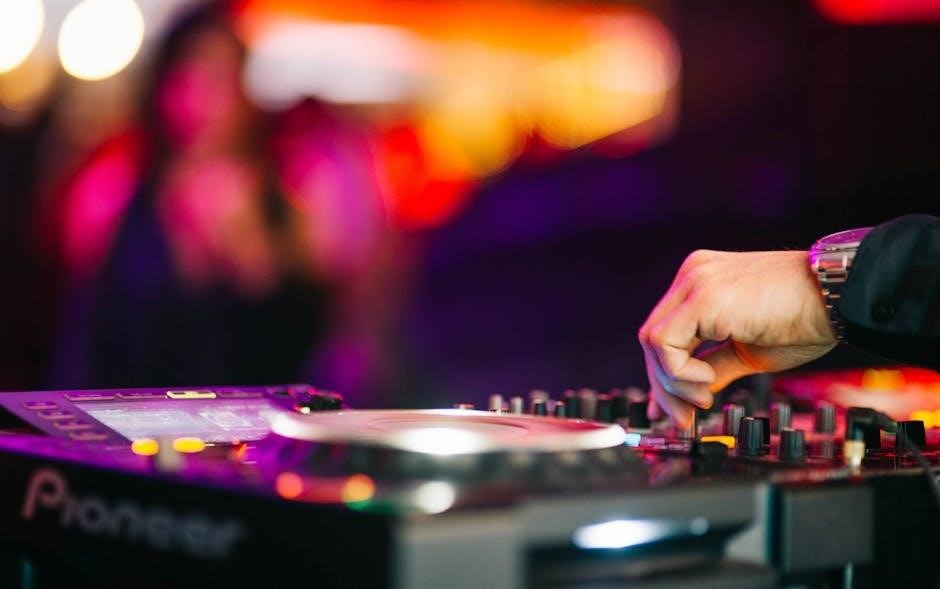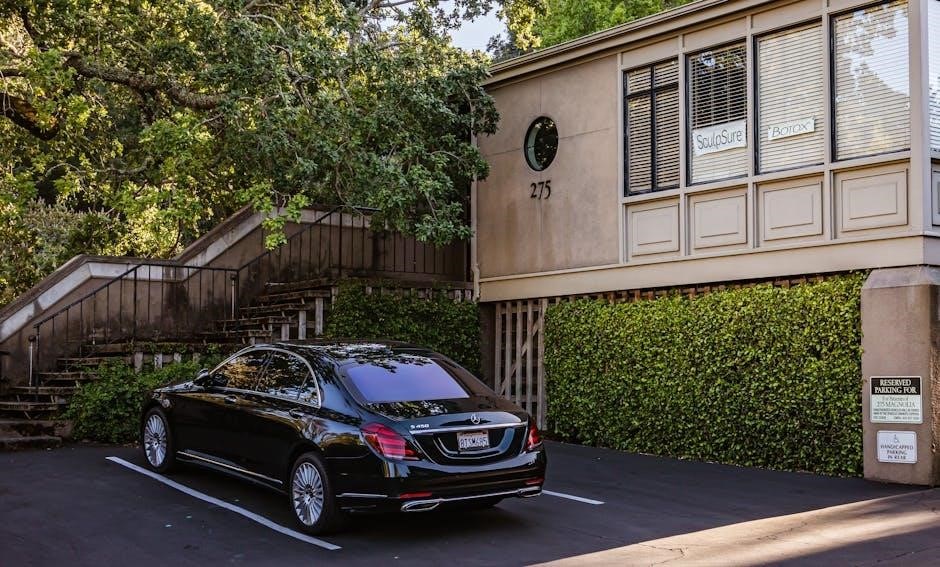An Exclusive Beat License Agreement is a legal contract granting an artist sole rights to use a producer’s beat, ensuring ownership and copyright protection while fostering creativity.
1.1. Definition and Purpose
An Exclusive Beat License Agreement is a legally binding contract between a music producer and an artist, granting the artist sole rights to use a specific beat. This agreement ensures the producer retains ownership while the artist gains exclusive usage rights. Its primary purpose is to protect both parties’ interests, outlining terms like usage permissions, royalties, and exclusivity. By defining clear boundaries, it prevents unauthorized use and ensures fair compensation. This agreement is crucial for maintaining creative control and fostering professional relationships in the music industry, providing a structured framework for collaboration and distribution. It is tailored to safeguard intellectual property and financial interests.
1.2. Key Parties Involved
The primary parties in an Exclusive Beat License Agreement are the producer and the artist. The producer is the creator of the beat, retaining ownership and intellectual property rights. The artist is granted exclusive usage rights to incorporate the beat into their music. Additional parties may include publishers or record labels, who manage rights and royalties. Sometimes, legal representatives are involved to ensure the agreement’s enforceability. These parties collaborate to establish a mutually beneficial arrangement, ensuring the producer is fairly compensated and the artist gains exclusive access to the beat for their creative projects. Clear roles and responsibilities are defined to avoid disputes.
1.3. Importance in the Music Industry
Exclusive Beat License Agreements are crucial for protecting creators’ rights and ensuring fair compensation. They allow producers to maintain ownership while granting artists exclusive usage, fostering collaboration and innovation. These agreements prevent unauthorized use and potential legal disputes, safeguarding both parties’ interests. By clearly defining rights and payments, they promote transparency and trust, enabling artists to focus on creative endeavors. This structure supports the music industry’s growth by establishing a standardized framework for beat licensing, ensuring that producers are valued for their work and artists can create without infringement concerns. Such agreements are essential for maintaining integrity and fairness in the industry.

Structure of an Exclusive Beat License Agreement
The agreement outlines ownership, usage rights, payment terms, and exclusivity, ensuring clarity and legal protection for both producers and artists, while maintaining industry standards and compliance.
2.1. Grant of Rights
The Grant of Rights section in an Exclusive Beat License Agreement outlines the specific permissions granted to the artist by the producer. This includes the exclusive right to use, reproduce, and distribute the beat in a final musical composition. The producer transfers these rights for a defined period, ensuring the artist can commercially exploit the work without interference. The section also specifies territorial limitations and any restrictions on sublicensing. Properly drafted, this clause safeguards both parties’ interests and prevents future disputes, ensuring clarity on how the beat can be legally utilized. It is a cornerstone of the agreement, providing legal assurance for both creator and user.
2.2. Ownership and Copyright Information
The Ownership and Copyright Information section clarifies that the producer retains full ownership of the beat, while granting the artist exclusive rights to use it. The producer’s copyright is protected, ensuring they remain the legal owner of the intellectual property. The artist, in turn, is granted exclusive rights to commercially exploit the beat for a specified term. This section also outlines how copyright notices and credits should be displayed, protecting both parties’ creative contributions. It ensures that the producer’s work is legally recognized while allowing the artist to benefit from its use in their projects. This balance is crucial for maintaining fairness and accountability.
2.3. Exclusivity Clause
The Exclusivity Clause ensures that the producer grants the artist sole rights to use the beat during the agreement’s term. This means the producer cannot license the same beat to other artists or use it for their own projects. The clause is legally binding, protecting the artist’s investment and ensuring the beat’s uniqueness to their work. It also prevents the producer from selling or distributing the beat elsewhere, maintaining exclusivity. This clause is crucial for both parties, as it safeguards the artist’s creative vision and the producer’s commitment to the agreement. It fosters trust and ensures the beat’s value is preserved.

2.4. Term and Termination
The Term and Termination clause outlines the duration of the agreement and the conditions under which it can be ended. It specifies the start and end dates, as well as any renewal options. Termination can occur if either party breaches the terms, fails to meet payment obligations, or violates exclusivity. The clause may also include notice periods, requiring one party to inform the other of termination in writing. Post-termination, rights to the beat may revert to the producer, and the artist may be required to cease use. This ensures clarity on the agreement’s lifespan and exit strategies, protecting both parties’ interests. Proper execution prevents disputes.
Payment Terms and Conditions
The section outlines payment structures, including upfront fees, royalties, and deadlines, ensuring clarity on financial obligations and schedules to prevent disputes.
3.1. Types of Payments (Upfront, Royalties, etc.)
Exclusive beat license agreements often include upfront payments, ensuring producers receive immediate compensation for granting rights. Royalties may be percentage-based or fixed, paid per use or sale. These terms are negotiable, balancing producer compensation with artist budget constraints. Payments may also include recoupment clauses, where royalties cover upfront fees before additional payments. Bonuses for milestones, like chart success, can incentivize quality. Payment structures vary, reflecting industry standards, track potential, and exclusivity. Clearly defining these terms prevents disputes, ensuring both parties understand financial obligations and expectations. Transparent payment schedules are crucial for maintaining trust and fostering long-term collaborations in the music industry.
3.2. Royalty Rates and Structures
Exclusive beat license agreements typically outline royalty rates ranging from 3% to 5% of total revenue generated by the song. These rates are often negotiable and may vary based on the producer’s reputation, the beat’s popularity, and the artist’s commercial success. Royalties can be structured as a percentage of sales, streaming revenue, or sync licenses. Some agreements include escalators, where rates increase if certain milestones, like album sales or chart positions, are met. Royalties may also be paid as a fixed amount per unit sold or stream. The structure ensures fair compensation for the producer while aligning with industry standards and market practices.
3.3. Payment Schedules and Deadlines
Payment schedules and deadlines in exclusive beat license agreements outline specific timelines for when payments are due. These schedules ensure transparency and accountability for both producers and artists. Typically, payments are divided into upfront fees and royalties, with deadlines clearly stated. For example, upfront payments may be due upon signing, while royalties are paid quarterly or annually. Late payments often incur penalties, such as interest fees or breach of contract claims. The agreement may also specify payment methods and currencies. Adhering to these schedules is crucial to maintaining a smooth working relationship and ensuring all parties fulfill their financial obligations promptly and efficiently.
Usage Rights and Restrictions
Exclusive beat licenses outline permitted uses, such as recording and distribution, while restricting unauthorized alterations, illegal activities, or transfers to third parties without consent.
4.1. Permitted Uses of the Beat
An exclusive beat license grants the artist the right to use the beat for specific purposes, such as recording, mixing, and distributing music. The artist is typically allowed to use the beat in one final musical composition, which may include albums, singles, or mixtapes. The license often permits synchronization rights for use in videos, films, or live performances. However, the producer retains ownership of the beat, and the artist cannot resell or transfer the beat to third parties. Usage is usually limited to the agreed platforms and territories, ensuring the producer’s work is protected while allowing the artist creative freedom.
4.2. Restrictions on Usage
Under an exclusive beat license, the artist is restricted from using the beat for unauthorized purposes. The beat cannot be resold, leased, or redistributed to third parties. Modifications to the beat require explicit permission from the producer. Additionally, the artist is barred from using the beat for illegal activities or content that defames the producer. Territorial and platform restrictions may apply, limiting where and how the beat can be used. The artist must also avoid any actions that could infringe on the producer’s copyright or diminish the beat’s value. These restrictions protect the producer’s intellectual property and maintain exclusivity.

4.3. Territorial Limitations
Territorial limitations define the geographic regions where the exclusive beat license is valid. The agreement may restrict usage to specific countries or grant worldwide rights. Producers often limit territorial rights to prevent unauthorized distribution in unapproved regions. Artists must adhere to these boundaries to avoid breaching the contract. If an artist wishes to expand usage to additional territories, they must negotiate with the producer. These limitations ensure the producer retains control over where their work is used, preventing over-saturation or unauthorized use in unintended markets. Territorial clauses protect both parties by clarifying the scope of permitted use. This ensures exclusivity is maintained.

Legal Considerations
Legal considerations ensure the agreement complies with relevant laws, protecting both parties’ rights. It outlines contract terms, intellectual property rights, and dispute resolution processes to avoid legal conflicts. Proper legal frameworks safeguard the producer’s ownership and the artist’s usage rights, ensuring all obligations are met. Consulting legal professionals is crucial to verify the agreement’s enforceability and fairness. This section emphasizes the importance of adhering to local, national, and international laws governing music licensing. A well-structured legal framework ensures clarity and protection for both parties involved in the exclusive beat license agreement. It is essential for maintaining professional integrity and avoiding disputes.
5.1. Governing Law and Jurisdiction
The governing law and jurisdiction clause specifies which state or country’s laws will apply to the exclusive beat license agreement. This is crucial for resolving disputes, as it determines the legal framework and venue for legal proceedings. Both parties must agree on the jurisdiction to ensure clarity and avoid conflicts. The clause typically includes the chosen jurisdiction’s laws, courts, and dispute resolution processes. It is essential to clearly outline this to prevent ambiguity and ensure enforceability. Properly defining the governing law and jurisdiction protects both the producer and the artist by aligning the agreement with recognized legal standards and procedures. This clause is non-negotiable and must be precise.
5.2. Dispute Resolution Mechanisms
Dispute resolution mechanisms outline the processes for addressing conflicts arising from the exclusive beat license agreement. Common methods include arbitration, mediation, or litigation. The agreement may specify a neutral third party or arbitration association to resolve disputes. Mediation is often preferred for its cost-effectiveness and ability to maintain relationships. The clause should detail the procedure, including notice requirements and timelines. It may also specify whether disputes must be resolved through alternative dispute resolution before escalating to litigation. Clear mechanisms ensure that conflicts are addressed efficiently, minimizing interruptions to the collaboration. Both parties should agree on the process to ensure fairness and mutual understanding. This clause is vital for maintaining smooth operations and protecting both parties’ interests.
5.3. Warranties and Representations
Warranties and representations in an exclusive beat license agreement ensure both parties provide accurate assurances. The producer typically warrants they own the beat, have the right to license it, and that it doesn’t infringe on third-party rights. The artist may warrant they will use the beat as agreed and not transfer rights without permission. These clauses establish accountability and protect both parties from potential legal issues. Breach of these assurances can lead to termination or legal action. Clear warranties and representations promote transparency and trust, ensuring the agreement is legally sound and enforceable. They are essential for safeguarding intellectual property and maintaining professional integrity.

Benefits of an Exclusive Beat License
An exclusive beat license offers artists unique sounds, enhancing their brand and appeal, while producers gain financial security and creative control, fostering long-term collaborations.
6.1. Benefits for the Producer
Producers benefit significantly from exclusive beat license agreements as they ensure sole ownership and usage rights, preventing unauthorized distribution. This exclusivity often leads to higher compensation, as artists pay premium for unique beats. It also offers creative control, allowing producers to influence how their work is used, aligning with their artistic vision. Exclusive agreements can foster long-term partnerships with artists, providing consistent work opportunities. Financially, producers gain stability through upfront fees or royalties, enabling investments in better equipment and projects. Enhanced reputation is another advantage, as successful collaborations increase visibility and attract more clients. Legal protections further safeguard their rights, ensuring proper credit and compensation, and minimizing the risk of piracy. Overall, exclusive agreements position producers as valued contributors in the music industry.

6.2. Benefits for the Artist
An exclusive beat license agreement offers artists a unique sound, enhancing their brand identity and differentiation in the competitive music industry. By securing exclusive rights, artists avoid the risk of their music sounding similar to others, which can harm their reputation. Exclusive beats often come with higher quality production, leading to better audience reception and commercial success. Artists also gain creative input, ensuring the beat aligns with their artistic vision. Additionally, exclusive agreements often include clauses that prevent the producer from re-selling the beat, granting the artist long-term control over their music. This exclusivity can lead to greater royalties and recognition, boosting their career trajectory and industry credibility. It also fosters trust and collaboration with producers, creating opportunities for future projects and mutual growth in the music industry.
6.3. Long-Term Opportunities
An exclusive beat license agreement creates a foundation for long-term success, fostering a consistent artistic identity and opening doors for sustained collaboration. Artists and producers can build a reputation for high-quality, unique music, attracting larger audiences and industry professionals. Over time, this exclusivity can lead to higher royalties and increased demand, as the artist’s brand becomes synonymous with their sound. Long-term partnerships often evolve, offering opportunities for album deals, touring, and merchandise. Exclusive agreements also position artists for better negotiating power in future contracts, ensuring they maintain creative and financial control. This setup can elevate both parties to new heights in the music industry.
How to Create an Exclusive Beat License Agreement
Creating an exclusive beat license agreement involves drafting clear terms, defining rights, and ensuring legal compliance. Start by outlining ownership, usage, and payment details. Include clauses on exclusivity, term, and termination. Consult a legal professional to review and finalize the document, ensuring it protects both parties’ interests and is enforceable under governing law.
7.1. Template Overview
An exclusive beat license agreement template provides a structured framework for outlining the terms of the agreement. It typically includes sections for producer and artist information, ownership details, usage rights, payment terms, and exclusivity clauses. The template ensures clarity and organization, covering key aspects such as copyright, territorial limitations, and termination conditions. It also includes placeholders for customization, allowing parties to tailor the agreement to their specific needs. A well-designed template simplifies the creation process, reducing the risk of overlooked details. It serves as a foundational document that can be adapted to various scenarios while maintaining legal enforceability and protecting both parties’ interests.
7.2. Customizing the Agreement
Customizing an exclusive beat license agreement involves tailoring its terms to fit specific needs. This may include adjusting payment structures, such as upfront fees or royalty rates, to reflect the project’s scope. The duration of exclusivity and territorial rights can also be modified based on the parties’ requirements. Additionally, clauses regarding usage permissions, like digital distribution or live performances, may need adaptation. Legal counsel is crucial to ensure that all modifications comply with copyright laws and protect both the producer and artist. Customization ensures the agreement aligns with the unique aspects of each deal, preventing future disputes and safeguarding intellectual property rights.
7.3. Legal Review and Finalization
Legal review and finalization are critical steps in creating a binding exclusive beat license agreement. Both parties should have their legal counsel examine the document to ensure it complies with copyright and contract laws. A lawyer can identify potential loopholes and suggest adjustments to protect the interests of the producer and artist. Once reviewed, the agreement is finalized by signing and dating it. This step ensures clarity, fairness, and enforceability. It also confirms that all terms, including payment, usage rights, and exclusivity, are agreed upon. Finalizing the agreement legally safeguards both parties and provides a clear framework for their collaboration.

Common Mistakes to Avoid

Common mistakes include ignoring legal advice, unclear payment terms, and not defining exclusivity or usage rights, which can lead to disputes and financial losses for both parties.
8.1. Overlooking Exclusivity Clauses
Overlooking exclusivity clauses is a common mistake that can lead to legal disputes and financial losses. These clauses define the scope of rights granted to the artist or label, ensuring the producer retains control over their work. If exclusivity is not clearly outlined, the beat may be used by multiple parties, diluting its value. Producers must specify territorial and temporal limits to prevent unauthorized use. Failure to include these details can result in conflicting agreements and loss of creative ownership. Always ensure exclusivity terms are explicit to protect both parties’ interests and maintain the beat’s uniqueness in the marketplace.
8.2. Unclear Payment Terms
Unclear payment terms are a significant oversight in exclusive beat license agreements, often leading to disputes and delayed compensation. Vague language regarding payment amounts, methods, or schedules can create confusion and mistrust between producers and artists. For instance, failing to specify whether payments are upfront, recurring, or based on royalties can result in miscommunication. Clearly defining payment structures, including percentages, timelines, and delivery methods, is essential. Ambiguity can delay payments or lead to underpayment, harming both parties’ financial interests. Ensuring transparency in payment terms fosters a fair and professional relationship, protecting the rights of both the producer and the artist.
8.3. Ignoring Legal Consultation
Ignoring legal consultation is a critical mistake when drafting an exclusive beat license agreement. Without legal expertise, parties may overlook essential clauses, leading to unenforceable terms or unprotected rights. A lawyer ensures the agreement complies with copyright laws and industry standards, safeguarding both producers and artists. Legal consultation helps clarify ambiguous terms, preventing future disputes. It also verifies that all rights, such as ownership and usage, are properly defined. Skipping this step can result in costly legal battles or lost revenue. Consulting a lawyer is a proactive measure to ensure the agreement is fair, binding, and tailored to the specific needs of both parties.

Case Studies and Examples
Real-world examples highlight successful exclusive licensing deals, lessons from disputes, and industry standards, providing practical insights into effective agreement execution and management.
9.1. Successful Exclusive Licensing Deals
A notable example is producer Metro Boomin’s exclusive deal with Boi-1da, which led to hit tracks for major artists like Drake and The Weeknd. Similarly, Mike WiLL Made-It’s exclusive agreement with Rae Sremmurd resulted in chart-topping singles like “Black Beatles.” These deals highlight how exclusivity can foster creative collaboration and commercial success. Both producers and artists benefit from aligned goals, ensuring high-quality output and mutual financial gain. Such cases demonstrate the effectiveness of exclusive licensing in producing impactful music that resonates with audiences worldwide.
9.2. Lessons Learned from Disputes
Disputes over exclusive beat licenses often arise from unclear terms or breaches of contract. For example, producers may claim artists exceeded usage rights, while artists may dispute royalty payments. A notable case involved a producer suing an artist for using a beat beyond the agreed territory. Courts often side with the party that provided explicit documentation. These disputes highlight the importance of clear, detailed agreements. Ensuring all terms, such as usage limits and payment structures, are explicitly outlined can prevent costly legal battles. Both parties must thoroughly review contracts to avoid misunderstandings and protect their rights.
9.3. Industry Standards and Practices
Industry standards for exclusive beat license agreements emphasize clarity, fairness, and transparency. Most agreements include standard clauses like exclusivity periods, royalty rates, and territorial limitations. Producers often use templates from trusted sources like legal forums or music industry organizations. A common practice is to negotiate terms upfront, ensuring both parties understand their rights and obligations. Many producers also include a “split sheet” to outline percentages for royalties and publishing. Platforms like BeatStars and Airbit offer templates that align with industry norms. Adhering to these standards helps protect creators and ensures smooth collaborations, fostering trust and long-term relationships in the music industry.
An exclusive beat license agreement is crucial for protecting rights and fostering fair collaborations in music production. It ensures clarity, legal security, and mutually beneficial outcomes for all parties involved.
10.1. Summary of Key Points
An exclusive beat license agreement is a legally binding contract between producers and artists, granting exclusive rights to use a beat in exchange for payment. It outlines ownership, usage rights, and payment terms, ensuring clarity and fairness. Key elements include the grant of rights, exclusivity clauses, royalty structures, and termination conditions. The agreement protects both parties by defining permitted uses, territorial limitations, and legal jurisdictions. It also highlights the importance of legal consultation to avoid disputes. By structuring these elements clearly, the agreement fosters successful collaborations and ensures long-term benefits for both producers and artists in the music industry.
10.2. Final Thoughts on Exclusive Licensing
Exclusive beat licensing offers a structured framework for producers and artists to collaborate effectively, ensuring both parties benefit fairly. It balances creative freedom with legal protection, preventing disputes and fostering trust. A well-crafted agreement clarifies rights, payments, and usage, allowing creators to focus on their craft. Both parties should seek legal advice to ensure their interests are protected. By understanding and adhering to the terms, exclusive licensing can lead to successful, long-term partnerships in the music industry, driving innovation and prosperity for all involved.
10.3. Call to Action for Further Research
For a deeper understanding of exclusive beat license agreements, download a sample exclusive beat license agreement PDF to review the structure and clauses. Explore additional resources, such as legal guides, articles, and industry forums, to gain insights into best practices. Consider consulting legal experts or music industry professionals to tailor agreements to your specific needs. Stay informed about copyright laws and licensing trends to ensure your agreements remain compliant and effective. By investing time in research and preparation, you can protect your rights and achieve successful licensing outcomes in the music industry.
